#Toxomerus
Explore tagged Tumblr posts
Text
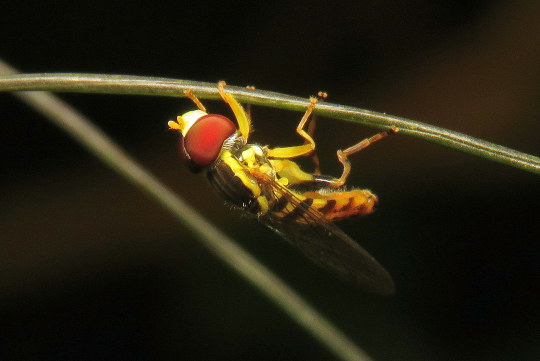
Bug of the Day
A wee hoverfly (Toxomerus geminatus) resting on a blade of fennel.
#hoverfly#Eastern calligrapher#bee mimic#fly#Toxomerus geminatus#Toxomerus#Syrphidae#Diptera#insect#that's not a bee!#bug of the day#BotD
210 notes
·
View notes
Text

Calligrapher fly (Toxomerus sp.)
0 notes
Text


Range: much of North America
#poll#Class: Insecta#Order: Diptera#Family: Syrphidae#Genus: Toxomerus#Toxomerus Marginatus#Range: Nearctic#Range: Neotropical#bug tw#insect tw
38 notes
·
View notes
Text

I'm participating in Art Fight this year (for the 7th time in a row!) I'll be pretty busy this month but I'm hoping to do quite a few attacks :D If you have insect/arthropod characters and are participating, DM me with a link to your profile! Link: http://artfight.net/~arthro
#art fight#p.s. the character in the circle is on my art fight#under “gemma toxomerus”#it's her larval form!
5 notes
·
View notes
Text

Today I bring you a little hover fly, Toxomerus politus from the Syrphidae family. They mimic bees and are important pollinators. Registered in Rio Grande do Sul, Brasil.
1 note
·
View note
Text
I see at least one cool bug a day, and usually many more, but it’s not because I live anywhere particularly rich in strange, wonderful creatures (I live in an unremarkable corner of Pennsylvania, USA) or spend all of my free time looking for bugs (well, just *most* of it). in my experience, finding interesting bugs is less about actually locating them and more about looking closely at tiny things you’d otherwise ignore!
this very long post was compiled over a couple days in late July, although I spent less than 10 minutes at a time searching. there’s a lot of fun creatures just out in the open.

plants are always a good place to start when looking for bugs, and I chose this small fig tree (Ficus carica) with a mulberry sapling friend. feeding on the sap of the fig and mulberry is the first group I’ll take a look at, the planthoppers:

these two are flatid bugs, Metcalfa pruinosa and Flatormenis proxima. flatids are slow-moving bugs that can be approached closely, but once they get tired of circling around stems to avoid you they may launch themselves into a fluttering flight with spring-loaded rear legs.
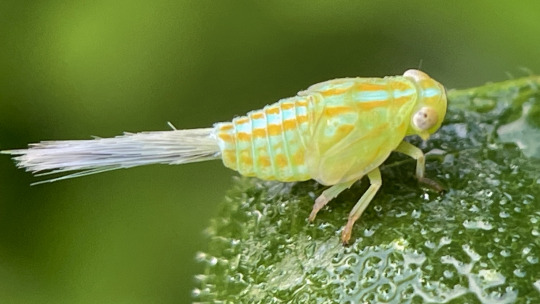
Aplos simplex, a member of the related family Issidae, also likes fig sap. its “tail” is actually a tuft of waxy secretions, which get shed along with the bright colors when it assumes a lumpy, bean-shaped adult form.
cicadellids, or leafhoppers, are just about everywhere on plants, but can be hard to approach without scaring them.


Agallia constricta on the left is a tiny species that feeds on grass, but many were scared up onto the fig by my footsteps. Jikradia olitoria is a much larger species that does feed on the fig; juveniles like this are curled, creeping goblins while adults’ rounded wings give them a pill-shaped appearance.
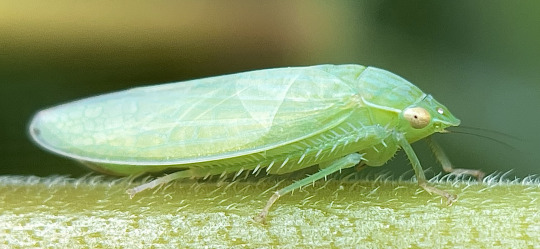
this big, pale leafhopper belongs to genus Gyponana. it’s tricky to get to species ID with these.
Graphocephala are striking little hoppers that eat a variety of native and nonnative plants. G. coccinea is the larger, more boldly colored one and G. versuta is smaller but more common locally. they’ll sit on the tops of leaves but take flight if you get too close quickly.


another group you’re almost guaranteed to encounter are flies (Diptera). these are a very diverse group, so much more than houseflies and mosquitoes (though I did run into both)
where I live, any plant with broad leaves is almost guaranteed to have a few Condylostylus, long-legged flies that come in shades of blue, green, and red. despite their dainty physique, they’re agile predators, typically feeding on other small flies.
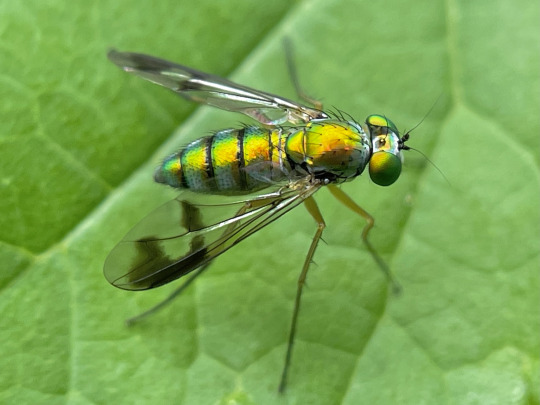
next, a few hoverflies: the ubiquitous Toxomerus geminatus and a Eumerus that I’ve been seeing a lot of this year (but maybe I’ve just noticed them for the first time). syrphids have varied life histories, but most adults drink nectar and many of the larvae are predaceous on aphids.
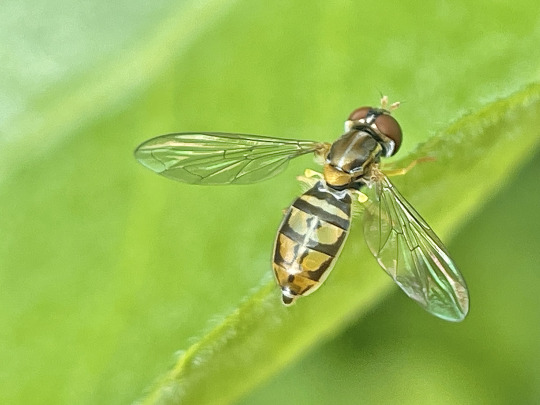

the metallic green soldier fly is Microchrysa flaviventris, nonnative here. Coenosia is a fun example of a “fly that looks like a fly,” with big red eyes and a gray body, and you might think they’re just another dung-sucking pest, but they’re actually aggressive predators! this one seemed to have nabbed itself some sort of nematoceran fly, maybe a fungus gnat.
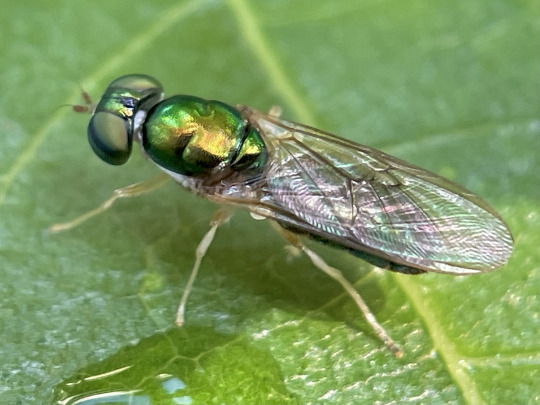

many flies are very tiny, just millimeters long. the first two little fellows are lauxaniids, while the last one, an agromyzid leafminer Cerodontha dorsalis, burrows through grass leaves as a larva.
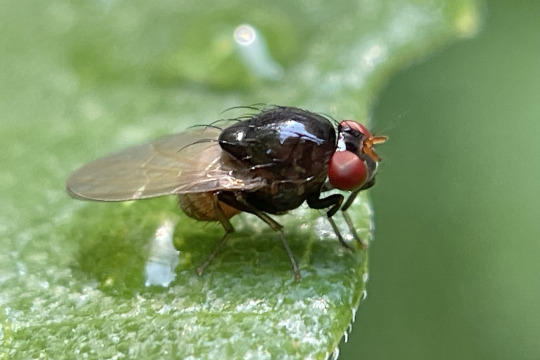
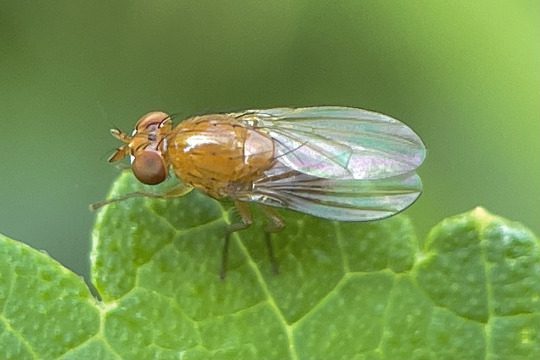

while moths and butterflies (Lepidoptera) are drawn to plants for their flowers or to lay eggs, many small moths can easily be found resting on or under leaves during the day.
these first two are tortricids, many of which are flat, rectangular moths resembling chips of bark or dead leaves. the apple bud moth, Platynota idaeusalis, feeds on a wide variety of hosts, while this beat-up old Argyrotaenia pinatubana would have developed in an edible tube nest of pine needles.


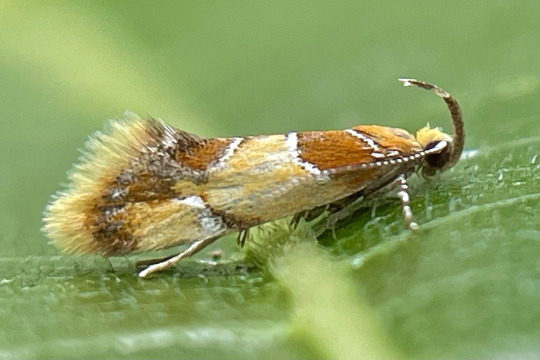
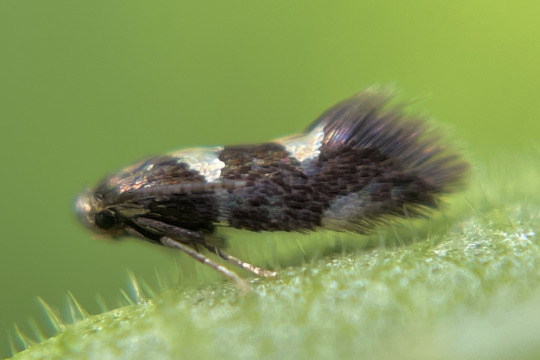
Callima argenticinctella feeds in bark and dead wood (a resource used by more caterpillars than you’d realize!) while the last moth, possibly an Aspilanta, is a leafminer.
although beetles (Coleoptera) are famous for their diversity, I didn’t find too many on the fig. the invasive Oriental beetle Exomala orientalis resting here can be found in a wide range of colors, from this common tan to to deep iridescent black. the other beetle is a Photinus pyralis firefly, sleeping under leaves as fireflies do.
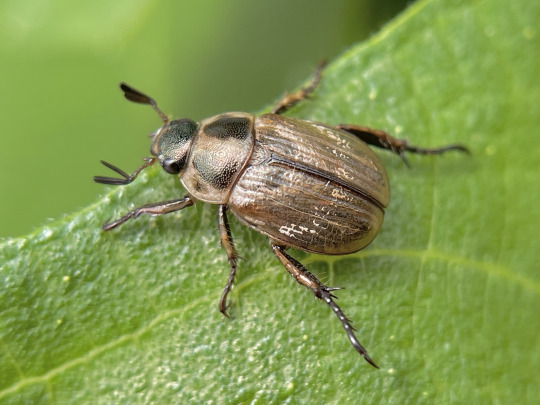
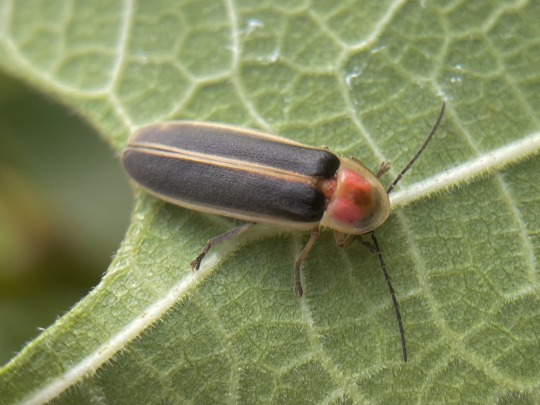
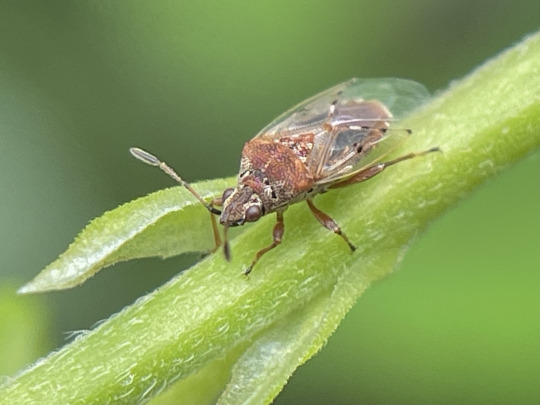
a few spare hemipterans: a Kleidocerys resedae that blew in on a wind, and below, the mulberry whitefly Tetraleurodes mori feeds on its namesake host. as for Hymenoptera, I saw manny tiny parasitic braconid wasps and various ants attracted to the planthoppers’ honeydew excretions—always worth checking underneath roosting hoppers for things having a drink.

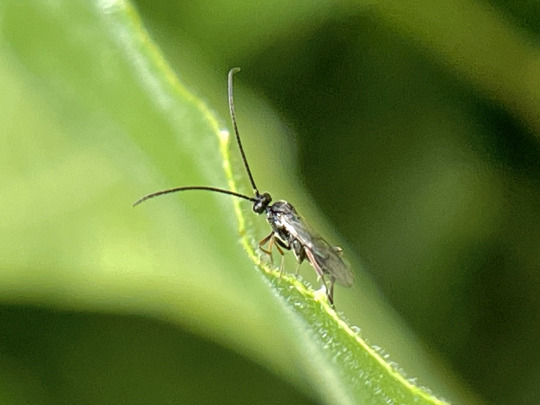
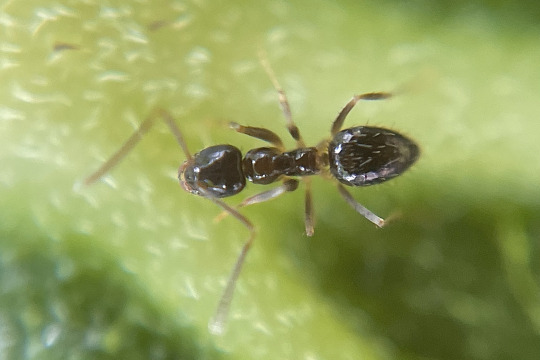
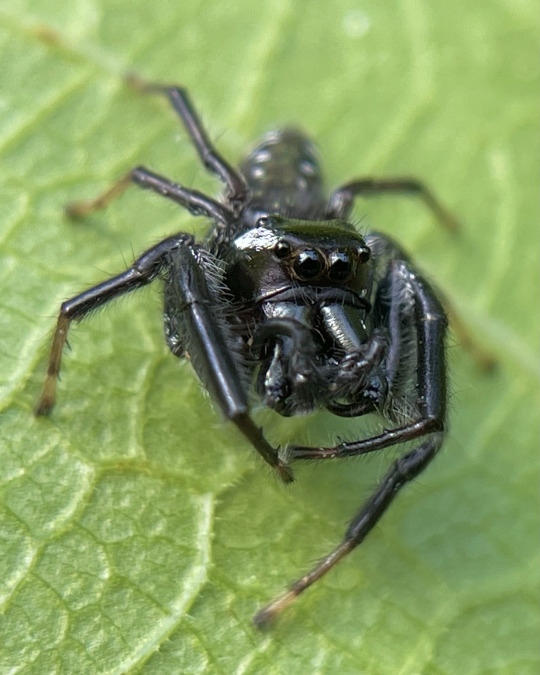
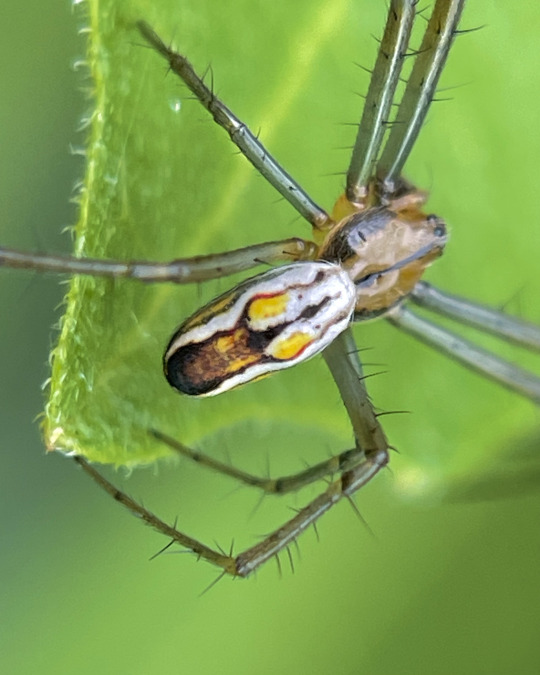
a couple handsome spider boys were scrambling through the fig seeking females, a jumping spider Paraphidippus aurantius and an orbweaver, Mecynogea lemniscata.
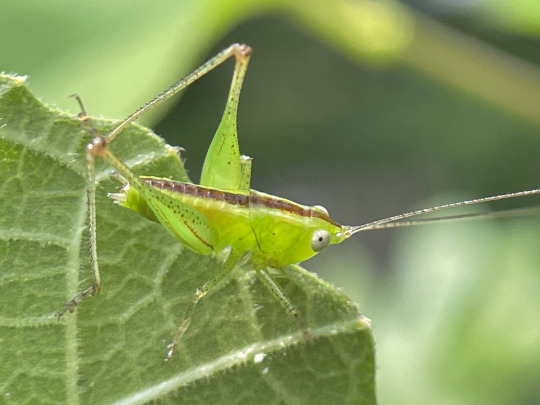

and to round it off, a young Conocephalus meadow katydid and a Carolina mantis, Stagmomantis carolina.
there’s 31 species of arthropod in this post, and I probably saw some 45, not all of which stayed for photos. if you walk slowly and look closely, you can see a sizeable chunk of your local biodiversity in under fifteen minutes! of course this will depend on where you live and what time of year it is, but there’s almost always more cool bugs out there than you’d expect, even on just a single plant.
1K notes
·
View notes
Text

Syrphid Fly (Toxomerus geminatus)
How splendid to begin the day by bathing in a dew drop.
26 notes
·
View notes
Text





Marginated Thin-Lined Calligrapher fly (Toxomerus boscii)(Toxomerus marginatus) on a Potentilla flower out back...
I stand corrected!
#nature#my photography#calligrapher fly#nature photography#hover fly#wildlife photography#flower fly#backyard nature#insect#potentilla#pollinators
13 notes
·
View notes
Text







Summer is Bursting with Bugs! (Species in order of presentation, my best guesses!)
Neokolla hieroglyphica Mecaphesa asperata Synema parvulum Bombus bimaculatus Toxomerus marginatus Mining Bee (Species uncertain!)
Though I don't get to see many reptiles and amphibians in Iowa, I at least get to see lots of bugs. Those that fly are particularly difficult to keep still while taking a quick photo, so I've been practicing taking clear shots on small subjects like them. In other news, I did go ahead and order a 200-800m lens, but it's been months and It seems I'm in the same boat as many others, waiting for that email of shipment. Once I get that though, it's literally a whole new world of possibility for me in terms of what kind of wildlife I can try and photograph!
#photography#summer#wildlife#animal photography#conservation#education#iowa#insects#bugs#bees#arachnids#wildlife photography
10 notes
·
View notes
Text
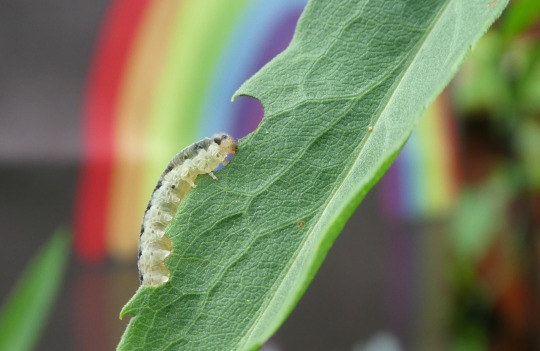




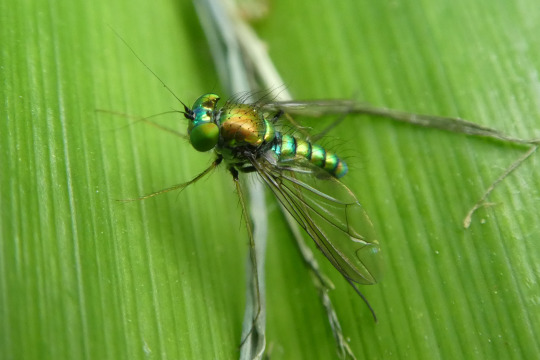

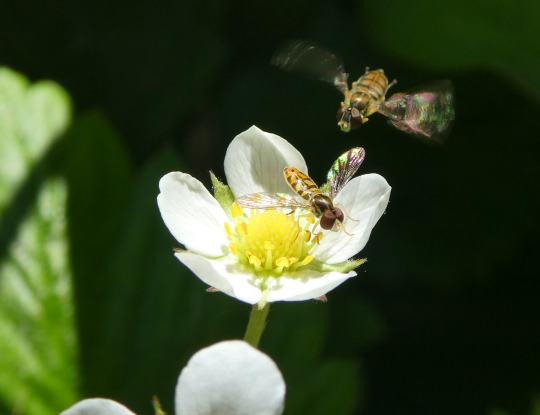


first half of june photos
(Symphytan larva, Dolichovespula maculata, Coleomegilla maculata larva, Sciurus carolinensis, Idana marginata, Condylostylus comatus, Platycryptus undatus, Toxomerus marginatus, Mephitis mephitis, and Scudderia furcata nymph)
#my pics#bugs#arthropods#rodents#skunks#spiders#animal photography#wasp#diptera#coleoptera#salticidae#katydid
8 notes
·
View notes
Text






Algunas fotitos que tomé últimamente. 🇨🇱
Hylephila sp. - Anthidium manicatum - Vanessa carye - Yramea cytheris - Austroscaeva melanostoma - Toxomerus vertebratus.
Canon R7 + RF 85mm F2 Macro IS STM
4 notes
·
View notes
Text















Zuzu's Bug-ventures: Home-stretch Edition!
As the title suggests, we're coming down the home stretch, since I live in an area with cold winters. I'm assuming after this, I won't be posting anymore collections, and instead singular photos, backlogs from previous years, and stuff friends have sent me
Small grass skipper butterfly (Atalopedes campestris). The 1 millionth skipper photo I've taken this year. Next year I hope to beat that record. This is the only flower left that they seem to like
Boxelder bug (Boisea trivittata). Here he is. Mr. Halloween colors himself. This was the first one I've seen all year, which is wild because there have been summers where the entire side of my parents' house was blanketed with them
Obscure sap beetle (Conotelus obscurus). Obscure is right. I'm assuming it's called obscure because it conceals itself in flowers, and not because I've never heard of or seen one before, lol
Eastern subterranean termite (Reticulitermes flavipes). I guess that's what this is? It was SUPER tiny
Eastern yellowjacket (Vespula maculifrons). I just thought it was really funny hanging around my laptop charger
Dusky stink bug (Euschistus tristigmus). Just a guy
Unsure of ID. Possibly a bowl and doily spider (Frontinella pyramitela). That's quite a name!
Unsure of ID. I found this on the underside of a leaf. I think it's a dead giant mosquito
Unsure of ID. Possibly a type of sweat bee (Halictus ligatus).
Emerald jumping spider (Paraphidippus aurantius). Cute friend, as are all jumping spiders
Cabbage white butterfly (Pieris rapae). Of course I've posted half a dozen of these over the summer, but this one I thought was really cute, reflecting the color of the flower
Guinea paper wasp (Polistes exclamans). This was the guy who landed on my shoulder out of nowhere. Startled the hell out of me, since I've never seen this kind of wasp before. They're supposedly relatively docile, especially this time of year
I have absolutely no clue what this is. My camera is trash garbage
Eastern calligrapher (Toxomerus geminatus). The wings are gorgeous in the sun
Southern yellowjacket (Vespula squamosa). This photo was courtesy of my dad, who found this at my grandparents' house. I'm surprised he got this close to this creature, as apparently it was quite large
And there you have it! It's been 4 months since I started Zuzu's Bug-ventures. I just tried to count how many different kinds of insects & spiders I've seen over the season, and I think I got to 204! I'm really proud of that-- it was honestly a blast to find them, identify them, and share them.
4 notes
·
View notes
Text


Calligrapher flies / genus Toxomerus
18 notes
·
View notes
Text
#1 hobby these days is just going on an evening walk through the neighborhood and using Seek to id any flowers or bugs i see :3


Common Soapwort Saponaria officinalis is nonnative but can be used to make soap!! Wild Four O’Clock Mirabilis nyctaginea is native and a host to at least four species of micromoths’ caterpillars.



Butterfly Milkweed Asclepias tuberosa is native and attracts butterflies and other pollinators including this common eastern bumble bee Bombus impatiens ! and this last guy is the Eastern Calligrapher Toxomerus geminatus, which is a native species of flower fly. they exhibit batesian mimicry with the yellow and black stripes but are harmless to humans; their larvae prey on pests like aphids.
1 note
·
View note


